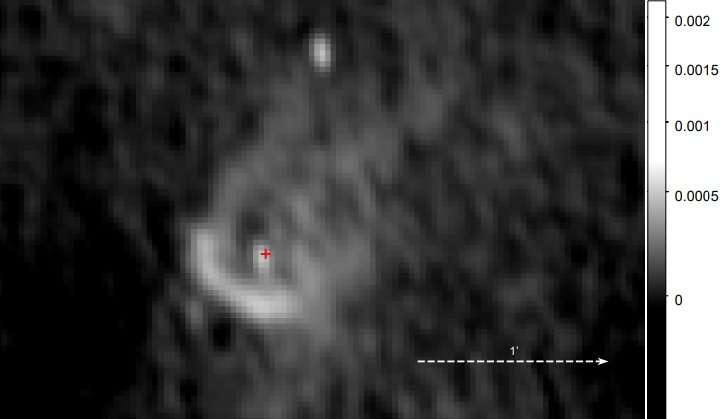March 21, 2018 report
Radio nebula discovered around the pulsar PSR J0855–4644

Using the Giant Metrewave Radio Telescope (GMRT) in India, an international team of astronomers has detected a diffuse radio emission forming a nebula around the pulsar PSR J0855–4644. The finding is reported March 9 in a paper published on the arXiv pre-print repository.
Discovered in 2003, PSR J0855–46444 is a young and energetic pulsar located some 3,000 light years away in the Vela region. Although the presence of an X-ray nebula surrounding this pulsar was detected by previous observations using NASA's Chandra X-ray observatory and ESA's XMM Newton spacecraft, there is an ongoing search for its radio counterpart.
Finding such X-ray and radio emission could be key for our understanding of the so-called pulsar wind nebulae (PWNe). Astronomers believe that pulsars lose a significant part of their energy via relativistic winds which, upon interactions with the ambient medium, produce a synchrotron powered nebula emitting from radio to beyond the X-ray bands.
In January 2017, a group of researchers led by Chandreyee Maitra of the Max Planck Institute for Extraterrestrial Physics in Germany, conducted observations of PSR J0855–46444 with the upgraded GMRT (uGMRT). In result, they found a radio counterpart of the PWN surrounding this pulsar.
"We report the discovery of a diffuse radio emission around PSR J0855–4644 using an upgraded GMRT (uGMRT) observation at 1.35 GHz. The radio emission is spatially coincident with the diffuse X-ray pulsar wind nebula (PWN) seen with XMM-Newton but is much larger in extent compared to the compact axisymmetric PWN seen with Chandra," the researchers wrote in the paper.
The astronomers noted that the spatial coincidence of the radio emission with the diffuse X-ray emission suggests that it is the radio counterpart of the PWN.
According to the study, the newly identified radio nebula has an estimated physical size of about 1.43 light years. Therefore, it turns out to be much larger than the compact axisymmetric X-ray nebula spotted by the Chandra spacecraft. However, the radio nebula is similar in size to the diffuse X-ray nebula observed with the XMM-Newton telescope.
"Since the higher energy X-ray electrons cool faster, the number of X-ray emitting particles decrease rapidly with increasing distance from the pulsar leading to a smaller size of the X-ray nebula compared to the radio counterpart," the scientists explained.
GMRT observations revealed that a central ring-like radio emission feature surrounds PSR J0855–46444, which is brightened at the southeast region. Furthermore, the researchers found that two tail-like features extend in the north-west direction and a faint diffuse emission fills the whole feature.
The authors of the paper assume that the morphology of the emission is reminiscent of a bow shock nebula.
"The PWN morphology strongly resembles a bow shock nebula and the radius of the termination shock indicates a velocity of 100 km/s through the ambient medium," the paper reads.
More information: Discovery of a radio nebula around PSR J0855-4644, arXiv:1803.03592 [astro-ph.HE] arxiv.org/abs/1803.03592
Abstract
We report the discovery of a diffuse radio emission around PSR J0855—4644 using an upgraded GMRT (uGMRT) observation at 1.35 GHz. The radio emission is spatially coincident with the diffuse X-ray pulsar wind nebula (PWN) seen with XMM but is much larger in extent compared to the compact axisymmetric PWN seen with Chandra. The morphology of the emission, with a bright partial ring-like structure and two faint tail-like features strongly resembles a bow shock nebula, and indicates a velocity of 100 km/s through the ambient medium. We conclude that the emission is most likely to be associated with the radio PWN of PSR J0855-4644. From the integrated flux density, we estimate the energetics of the PWN.
© 2018 Phys.org



















